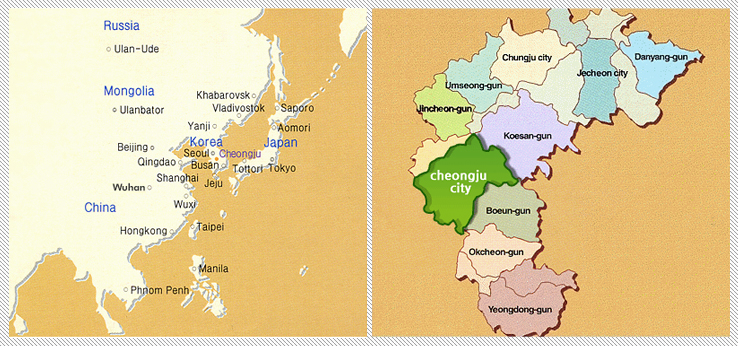
Distinct four seasons, inland city locate the central part of the Korea, good for living Cheongju a beautiful city with a good climate Cheongju is an inland city located 128km from southeast of Seoul. It adjoins Daejeon, Cheonan, Goisan and Boeun with in 40km and is 2-3 hours away from Gwangju, Busan and Jeju by land and air, The entrance into Cheongju is through the Cheongju Interchange, which is 119.6kms. away from Seoul. At the Gyeongbu Expressway, a 5km, tree-lined tunnel warmly welcomes you. Mt. Uam covers the city and Musimcheon passes through its Central downtown. It is known as the "city of education and culture." It is a center of politics, economics, education, culture and tourism as well as administration, with the provincial office of North Chungcheong Province located here.


Cheongju has a temperate continental climate with 4 distinct seasons: a high-temperature, humid and dry summer at its southeastern or southwestern parts, a cold, dry season at its northwestern part, a rainy season, and winter Compared to other regions, it has more pronounced differences between summer and winter, with relatively mild and good climate conditions at an average temperature of 11.6℃considering the 11℃ national average temperature. Its average annual rainfall is over 1,200mm, with intensive rains from June to September. Cheongju provides easy access to major Tourist sites in its vicinity such as Mt. Songni, Suanbo spaand Mt. Wolak, and enjoys abundant water from the Daecheong dam and low-cost land, which are the best conditions for the growth of state-of-the art industries
| Classification | Average | Highest ever recorded | Lowest ever recorded | Remarks |
|---|---|---|---|---|
| Temperature | 12.7℃ | 37.8℃ (July 23, 1994) | -26.4℃(February 6, 1969) | |
| Rainfall | 1,387.6mm | Most rainfall ever recorded in one day: 293mm (Aug 25, 1995), maximum rainfall ever recorded in one hour: 62.7mm (July 3, 1981) |
||